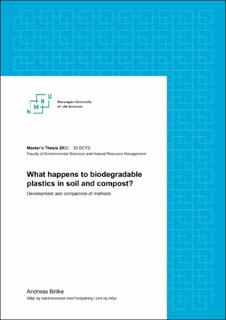| dc.contributor.advisor | Coutris, Claire | |
| dc.contributor.advisor | Rivier, Pierre-Adrien | |
| dc.contributor.advisor | Joner, Erik J. | |
| dc.contributor.advisor | Almås, Åsgeir R. | |
| dc.contributor.author | Brilke, Andreas | |
| dc.date.accessioned | 2020-09-10T12:15:52Z | |
| dc.date.available | 2020-09-10T12:15:52Z | |
| dc.date.issued | 2020 | |
| dc.identifier.uri | https://hdl.handle.net/11250/2677268 | |
| dc.description.abstract | Plastics in terrestrial ecosystems negatively affect their functioning by altering physical properties and disturbing soil microorganisms. The same could be true for biodegradable plastics entering nature through incomplete degradation in composting plants, and their subsequent application to soil in fertilizer substrate. So far, no standard analysis protocol for biodegradable plastic degradation exist. This Master's thesis has focused on developing methods for the analysis of biodegradable plastic degradation in a compost matrix and lays a foundation which later research can be built upon.
Fenton's reagent and hydrogen peroxide were tested as a sample up-concentrating pre-treatment of an organic matter matrix containing biodegradable microplastics. The degradation of four different biodegradable plastics in nylon bags in a compost tumbler and a compost oven incubation were assessed. Samples for pH and phospholipid fatty acids (PLFA) of different treatments were collected to compare their development and interchangeability. Fenton's reagent was the better suited up-concentrating pre-treatment for samples with some uncertainty remaining. Assessing the biodegradable plastic degradation indicated an incomplete process in home composts and (Norwegian) composting plants. pH values coarsely reflected the composting conditions and suggested interchangeability of most treatments. Analysis of pH together with PLFA results would have been optimal, but could not be accomplished as the COVID-19 epidemic hindered the PLFA analysis. While some uncertainties in the developed methods remain, it can be concluded that a basis for establishing biodegradable plastic degradation analysis was created. Subsequent research should continue their development to assess whether biodegradable plastic remains from composting plants contribute to the accumulation of plastics in terrestrial ecosystems. | en_US |
| dc.description.abstract | Plast i terrestriske økosystemer kan negativt påvirke økosystemenes funksjon ved å forandre fysiske egenskaper og forstyrre mikroorganismer i jord. Det samme kan gjelde for bionedbrytbar plast som kommer inn i naturen på grunn av ufullstendig nedbrytning i komposteringsanlegg og påfølgende tilføring til jord gjennom gjødsel. Det finnes ingen standardmetoder for å analysere degradering av bionedbrytbar plast ennå. Denne masteroppgaven har fokusert på å utvikle analysemetoder for bionedbrytbar plast i kompost og utgjør en basis som videre forskning kan bygge på.
Fentons reagens og hydrogenperoksid ble tested som forberedelsesmetode for organisk materiale som inneholder bionedbrytbar mikroplast. Degraderingen av fire forskjellige bionedbrytbare plasttyper i nylonposer plassert i en roterbar kompost og i en kompostinkubasjon i en ovn ble undersøkt. Videre ble det tatt kompostprøver for fosfolipidanalyse (PLFA-analyse) fra behandlingene (roterende kompost, nylonposer i en roterende kompost, 1.5L inkubasjon i en ovn), og pH ble målt for å sammenligne deres utvikling og kompatibilitet. Fentons reagens var den best egnete forberedelsesmetoden for prøver, men resultatet var fortsatt noe upresist. Undersøkelsen av nedbrytningen av bionedbrytbar plast tydet på at nedbrytningen i hagekomposter og i (norske) komposteringsanlegg er ufullstendig. pH-verdier er indikatorer for komposteringsforholdene. og resultatene tyder på at de fleste behandlingsmetodene kan byttes ut med hverandre. Analyse av pH-verdiene sammen med PLFA-resultatene ville vært optimalt, men ble forhindret på grunn av at COVID-19-epidemien gjorde PLFA-analysen umulig. Selv om noen usikkerheter i metodeutviklingen eksisterer, kan man slå fast at det ble etablert en basis for å utvikle standardmetoder for analyse av bionedbrytbar plast. Videre forskning burde bygge videre på dette arbeidet for å undersøke om bionedbrytbare plastrester fra komposteringsanlegg bidrar til akkumulering av plast i terrestriske økosystemer. | en_US |
| dc.language.iso | eng | en_US |
| dc.publisher | Norwegian University of Life Sciences, Ås | en_US |
| dc.rights | Attribution-NonCommercial-NoDerivatives 4.0 Internasjonal | * |
| dc.rights.uri | http://creativecommons.org/licenses/by-nc-nd/4.0/deed.no | * |
| dc.subject | Composting | en_US |
| dc.title | What happens to biodegradable plastics in soil and compost? : development and comparison of methods | en_US |
| dc.title.alternative | Hva skjer med bionedbrytbar plast i jord og kompost? : utvikling og sammenligning av metoder | en_US |
| dc.type | Master thesis | en_US |
| dc.subject.nsi | VDP::Mathematics and natural science: 400 | en_US |
| dc.source.pagenumber | 57 | en_US |
| dc.description.localcode | M-MINA | en_US |

